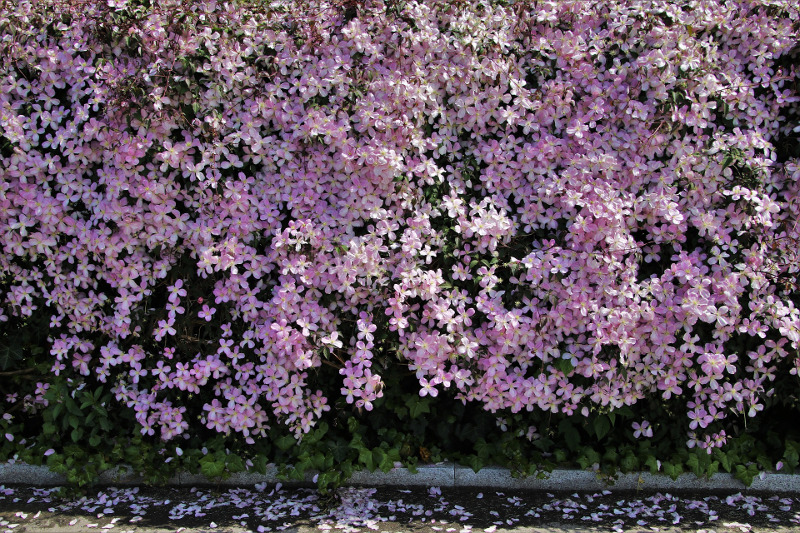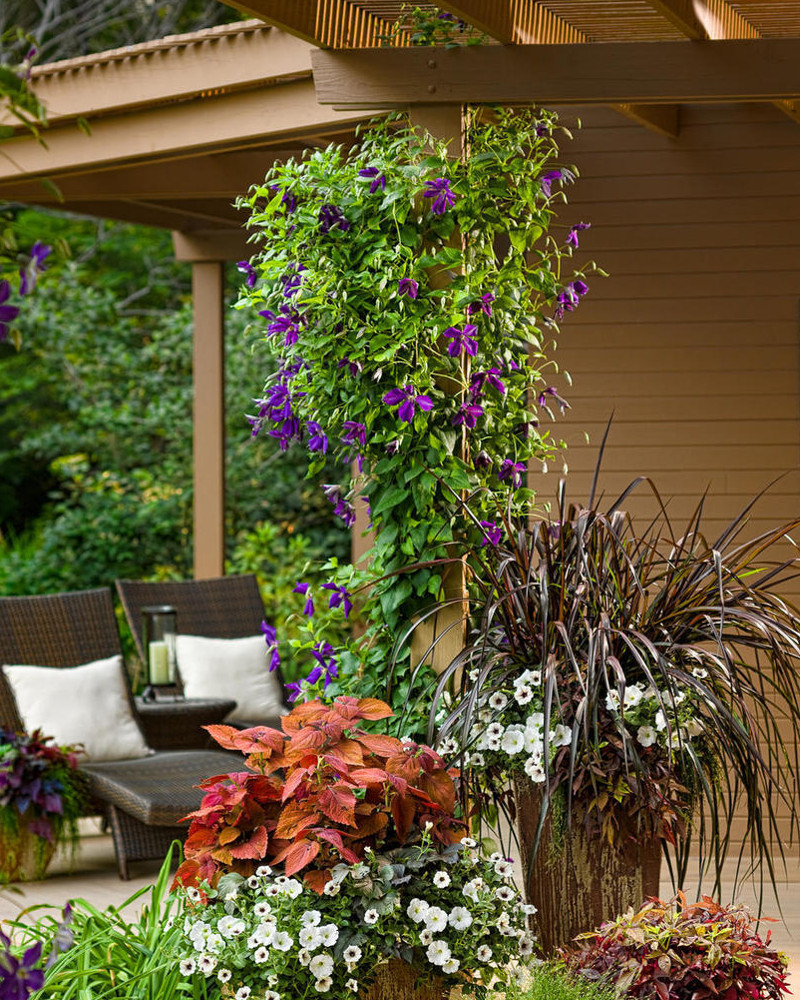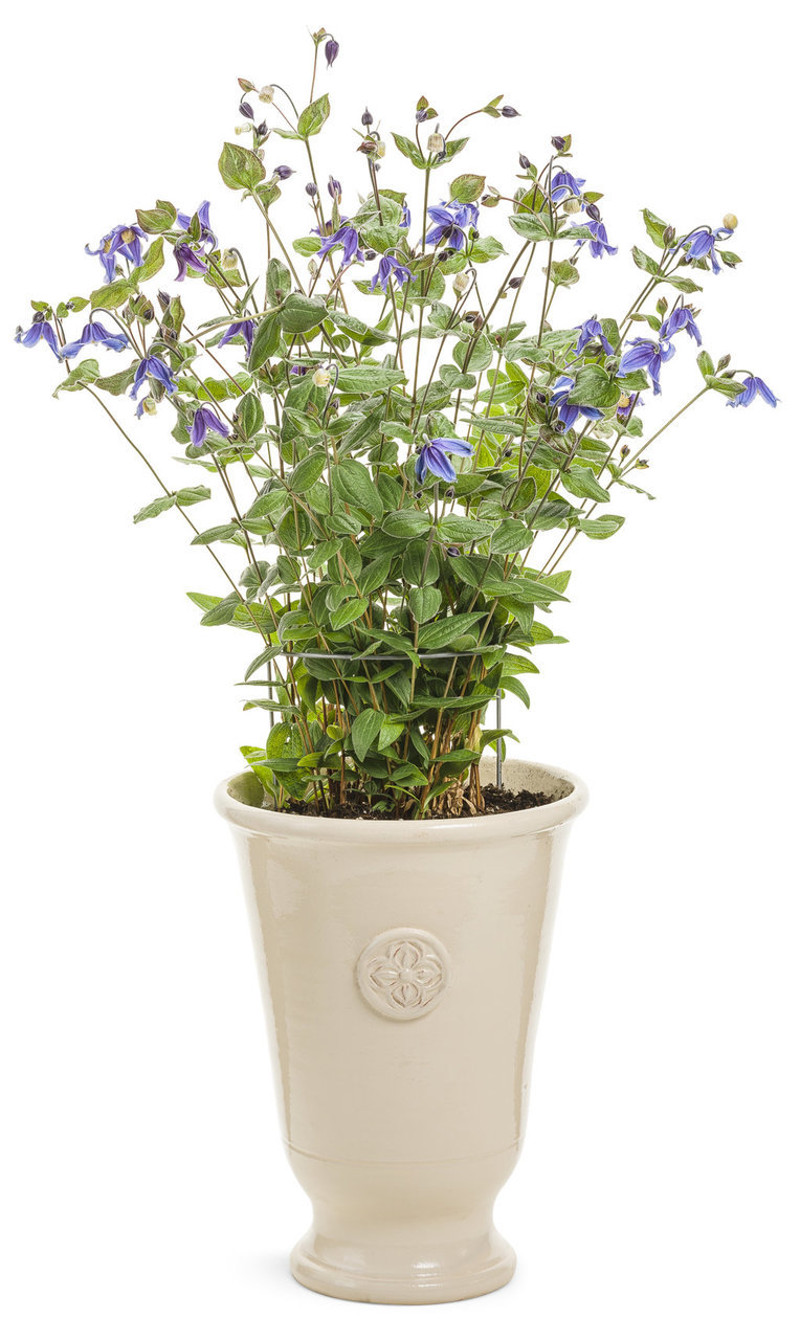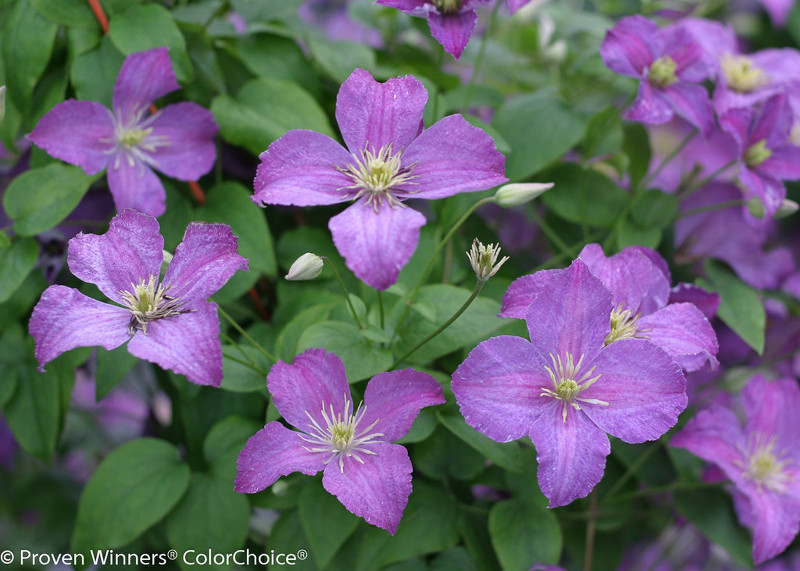Author Beth Stetenfeld Last Updated 10-4-2021
Clematis plants add height, structure, and elegant beauty to any garden. Though they can be tricky to start, once established they’re easy-care, reliable bloomers. Clematis (pronounced kleh·muh·tuhs) is a genus of about 300 species within the buttercup family, Ranunculaceae. The genus name is from Ancient Greek clématis, meaning "a climbing plant". These plants are mostly known as a vine that profusely flowers all summer.
The vines can grow up to to be 30 feet tall. The most well known variety is Clematis jackmanii, which has purple flowers that bloom from July to late fall. Most people grow clematis up a trellis, a garden arch or the side of a building. The flowers are typically purple, however the blooms can also be pink and white. The flowers can also be very fragrant.

These plants are typically native to China and Japan. However, there are some species that are native to North America. Those species were actually known to be used by Native Americans in herbal remedies to help with migraines and sore throats. In Europe during the Victorian era, the clematis flower would symbolize both mental beauty and art as well as poverty. Clematis is also sometimes called traveller's joy, old man's beard, leather flower, and vase vine.
Let’s take a look at six key steps to establishing healthy Clematis plants.
1. Select The Best Clematis
First, you’ll want to choose a plant that’s right for your garden conditions, location, and preferred bloom time. There are more than 300 species of Clematis and hundreds of hybrids—all of them members of the Ranunculaceae (Buttercup) family. There are early-flowering and late-flowering varieties and small- and large-flowered plants. Some grow as vines, others as small shrubs or trees, and still others as trailing or ground-cover plants.
Consider your garden zone, soil type, nearby plants, and sunlight conditions, as well. Different species and hybrids require different combinations of all these garden elements.
With all these options, selecting the type that’s right for your garden will be perhaps the most important step in adding Clematis to your collection. For example, ‘Jolly Good’ is a vining deciduous variety with plentiful lavender-colored flowers that bloom during the summer. ‘Stand By Me’ is a shrub-forming plant with blue bell-shaped flowers that appear in late spring.
2. Choose The Best Location For Clematis
It’s been said that Clematis plants like “their feet in the shade and their faces in the sun.” Part of the reason is that they need cool, moist (but well-draining) soil for their roots, and enough sunlight to produce blooms. But some Clematis varieties are more shade-tolerant than others. Also, consider the blooming time. If your site is south-facing in a deciduous woodland, a spring-blooming Clematis likely will get plenty of sunlight before the trees leaf out.
A dry site, or one where the Clematis will need to compete for soil moisture, probably isn’t best. On the other hand, too much moisture can encourage slugs or fungal disease, so make sure the location is well-draining.
Consider the surrounding plants: Will your new Clematis complement existing plants and structures in the area? If not, perhaps it’s better suited to a different location.
3. Providing Support For Clematis
If your Clematis is a climbing vine, make sure you have a structure prepared to support it. Clematis vines, depending on the variety, can grow up to 15 feet tall: one example is ‘Sweet Summer Love.’ When fully grown and full of foliage and flowers, the vines can be quite heavy and will need strong support. You’ll want to have the structure ready so it can start climbing as soon as it’s ready!
Climbing Clematis will grow on almost any structure that provides clasping points for the vines to grasp. Chicken wire, a trellis, or fencing materials provide good support. The more contact points, the better—to make sure the vines will be secure during storms and with strong winds.

If your Clematis will be in a pot, even if it’s more of a shrub form, like Stand by Me Clematis, you might want to have a post or some support, particularly if the conditions are windy, the plant is in partial shade, or it’s placed in a pot. When full of blooms, the plants can become top-heavy.

4. Protecting Clematis
Rabbits will eat Clematis. For this reason, and because the plants prefer moist, cool feet, it’s a good idea to place chicken wire, light mesh, or some other light protection around the bottom of the plant. Many gardeners place other plants around the base of the Clematis to achieve this goal. But if you have a rabbit problem, you’ll want to include a more solid barrier like chicken wire.
Make sure to keep the area open enough to allow access for watering during dry, hot weather or if your Clematis is placed under an eave or roofing line. Clematis plants suffer during drought, but, remember, they don’t want soggy feet either, so make sure your soil drains well. If you have naturally heavy or clay soil, amend it with some sand or vermiculite for better drainage.
5. Fertilizing & Watering Clematis
During rainy weather, and if your Clematis plant is in an open area that receives regular (several times per week) rainfall, there’s no need to water it. During a dry spell, water the plant a few times during the week to keep the soil moist. If direct rain is blocked by a roof line or overhang, water your Clematis regularly to maintain soil moisture.
Start with healthy garden soil at the planting site, and fertilize with a light, balanced fertilizer in spring, summer, and fall. If the Clematis shows signs of stress, test the soil around it first to determine any deficiency and the necessary treatment to overcome it. Clematis prefers neutral soil, so adding high-quality compost around the base will help maintain a healthy balance of nutrients.

6. Pruning Clematis
This is where things can get a little tricky. All Clematis plants benefit from an occasional light (emphasis on light!) pruning. But that’s where the generality ends. Some Clematis varieties bloom only on old wood, some bloom on new growth, and still others bloom on both. Determine which type you have before pruning.
Those that bloom only on old growth need pruning only if they’re overgrown. Be very careful not to prune out all of next year’s blooms! Similarly, those that bloom on both old and new growth generally only need a light pruning each year after blooming. Those that bloom only on new growth can be cut back to about 12 inches in early spring.
Follow these steps, and you’re on your way to lush, healthy Clematis plants that will bloom abundantly for years to come.
-
Select The Best Clematis
-
Choose The Best Location For Clematis
-
Providing Support For Clematis
-
Protecting Clematis
-
Fertilizing & Watering Clematis
-
Pruning Clematis
When growing clematis, it is important to remember.
First year they sleep.
Second year they creep.
Third year they leap!
Plants We Recommend
Common Questions About Clematis
What Growing Zones Will Clematis Grow In?
When growing clematis plants in the garden, there are varieties that are cold hardy in zones 3 to 9. These plants are typically known to be perennial vines, however they can be shrubs as well. There are some varieties that can survive in zone 10 as well, including Clematis 'Ernest Markham'.
Do Clematis Need Full Sun?
Clematis plants will do the best when growing in full sunlight conditions, that get at least 6 hours of direct sunlight per day. Clematis will grow into healthy plants in partial shade as well, but the plant will likely not produce as many flowers. Some varieties do better than others in partial shade conditions, including clematis 'nelly moser' and clematis 'henryi'.
Is Clematis Drought Tolerant?
Clematis are tough, but they don't particularly do well when they're being denied a drink of water and the leaves will start to wilt whey they're thirsty, and eventually yellow, brown, and fall to the ground. Likewise, they do not like to be over-watered and have soggy feet. If they're getting too much to drink, old and even new leaves will fall to the ground.
How Do I Keep My Clematis Healthy?
Watering clematis during the morning hours is important, to make sure water has time to be absorbed before it evaporates. Water your clematis when the top 1 inch of soil is dry. They prefer consistently moist soil, not too wet and not too dry. Clematis also prefer a soil that is neutral, so test periodically and make necessary adjustments with good quality compost. A nice balanced fertilizer a few times a year is also recommended.
How To Revive A Clematis?
If your clematis is suffering greatly, you can prune it back past affected areas, even below the ground if necessary. This will encourage fresh new growth from the ground up!
Why Does Clematis Leave Turning Yellow?
Yellowing leaves on a clematis may mean a nutrient deficiency, most likely iron or magnesium. If it's iron, amending the soil with iron chelate will help. If it is a magnesium deficiency, this can be remedied by combining one gallon of water with one teaspoon of Epsom salt. Watering your clematis with this concoction four times a month will help return them to their previously rich shade of green!
Why Does Clematis Leave Turning Brown?
Clematis leaves turning brown can be signs of a fungal infection such as leaf spot or clematis wilt. Both will require removing and destroying (to prevent spread to other plants) all affected areas, even if that means pruning all the way to the ground. Another cause of browning leaves can be root rot and affected leaves, even new ones should be removed and destroyed, this will help increase air circulation. Be careful not to overwater clematis, or to allow water to splash onto them while you're watering.
What Is The Growth Rate For Clematis?
How fast clematis grows is obviously affected by many factors, soil quality, watering habits, climate, etc. but they've acclimated well to their new home, they can be very fast growers. Some varieties will grow a couple of feet a year and some up to over 20 feet annually!
Do Clematis Spread?
Sweet Autumn Clematis is considered to be a highly invasive variety, and it is a vigorous grower, spreading up to 30 feet, and it easily reseeds itself.
Does Clematis Come Back Every Year?
Clematis are perennials, coming back each year. There is a saying about clematis, "The first year they sleep, the second year they creep, and the third year they leap!" Once their roots systems get well established, they are strong growers.
Have a question about Clematis? Fill out the form below and we will try and get back to your question as soon as possible. We may even feature your question in this article to help other gardeners!
